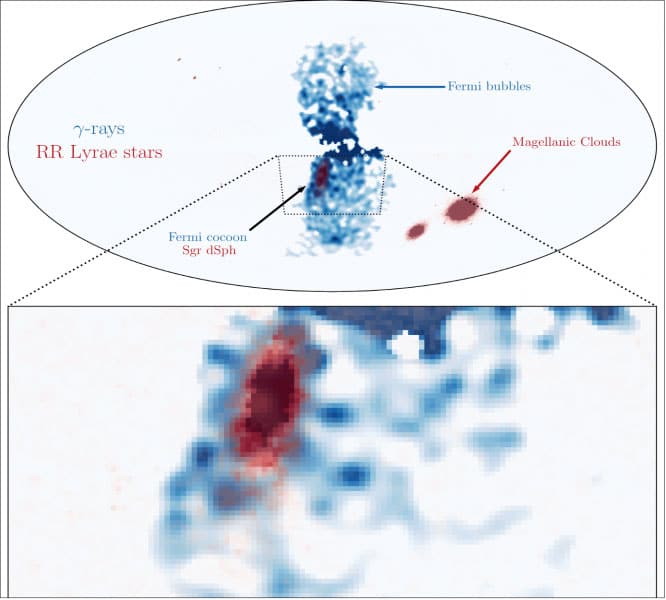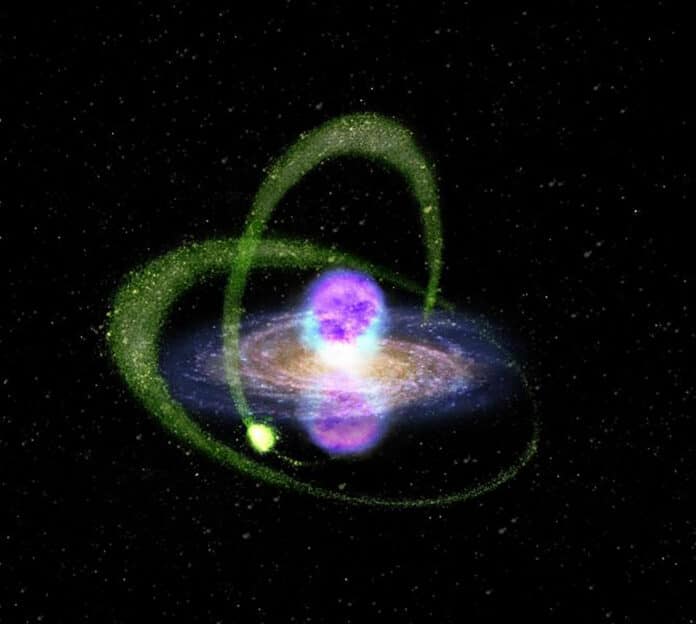An international team of scientists has discovered a small satellite galaxy of the Milky Way that is packed with dark matter through huge lobes of gamma radiation but whose emissions are more likely the product of millisecond pulsars blasting out cosmic particles.
Their discovery sheds light on millisecond pulsars as efficient accelerators of highly-energetic electrons and positrons. It also revealed that similar physical processes could be ongoing in other dwarf satellite galaxies of the Milky Way.
The galactic core of our galaxy is blowing a pair of enormous gamma radiation bubbles that are 50,000 light-years large. This hourglass-shaped anomaly was spotted using the Fermi Gamma-ray Space Telescope roughly ten years ago, but its origin has remained a mystery.
These bubbles are called fermi bubbles, whose radiation lobes are patched with a few enigmatic substructures of very bright gamma-ray emission. Fermi cocoon is one of the brightest spots found in the southern lobe and was initially thought to be due to past outbursts from the Galaxy’s supermassive black hole.
An international team of scientists co-led by former Kavli Institute for the Physics and Mathematics of the Universe (Kavli IPMU) Project Researcher Oscar Macias (currently GRAPPA Fellow at the University of Amsterdam) and Australian National University Associate Professor Roland Crocker, and including Kavli IPMU Visiting Scientists Shunsaku Horiuchi and Shin’ichiro Ando, analyzed data from GAIA and Fermi space telescopes to reveal that the Fermi cocoon is actually due to emission from the Sagittarius dwarf galaxy.

Scientists saw this satellite galaxy of the Milky Way through Fermi bubbles from our position on Earth. It has lost most of its interstellar gas due to its close orbit around our Galaxy and previous trips through the galactic disc. Additionally, many of its stars have been torn from their cores into elongated streams.
There were only a few explanations for Sagittarius’ gamma-ray emission because it was dormant, lacking both star nurseries and gas. One of them was either a population of unknown millisecond pulsars or dark matter annihilations.
Because of their incredibly high rotational energy, millisecond pulsars are the remains of specific sorts of stars that were in near-binary systems and were far more massive than the Sun. The Cosmic Microwave Background’s low-energy photons hit the electrons produced by millisecond pulsars, accelerating them to high-energy gamma radiation.
Scientists disfavored the dark matter theory by demonstrating that millisecond pulsars could explain the gamma-ray cocoon in the Sagittarius dwarf.
Macias said, “This is significant because dark matter scientists have long believed that observation of gamma rays from a dwarf satellite would be a smoking gun signature for dark matter annihilation. Our study compels a reassessment of the high energy emission capabilities of quiescent stellar objects, such as dwarf spheroidal galaxies, and their role as prime targets for dark matter annihilation searches.”
Journal Reference:
- Crocker, R.M., Macias, O., Mackey, D. et al. Gamma-ray emission from the Sagittarius dwarf spheroidal galaxy due to millisecond pulsars. Nat Astron (2022). DOI: 10.1038/s41550-022-01777-x
